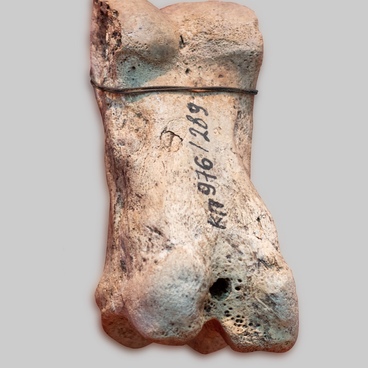Traditionally, agriculture has not been the primary occupation of the residents of Russian northern regions due to harsh weather conditions. Instead, crafts and trade were widespread. Hunting walruses for their tusks was a traditional trade of the PomOrs and the people living along the northern rivers of Pinega, Mezen and Pechora. Walruses were hunted near the island of Vaigach and at the Novaya Zemlya coasts. In the tundra, fossil (‘blue’) bones were mined, i.e., mammoth tusks that were valued on level with the walrus tusks. Northern Dvina river region is a traditional area of stockbreeding, and cattle, meat and ‘salo’ (bacon) trading.
In winter the residents of Kholmogory and Dvina river region took their merchandise by a sleigh road to Arkhangelsk and Moscow, and starting from XVIII century, to Saint-Petersburgh. Long bones of horned cattle (‘tsEvka’) were used in bone carving. They were degreased, sawed into narrow plates that could be easily engraved and painted in bright colors. ‘Tsevka’ was used for making combs and for garnishing chests.
Bone carving was quite developed in Kuznetsk. Multiple blanks and semifinished products were found there: knife handles, arrowheads, buttons and others. However, most delicately carved bone plates decorated expensive items brought in from the European part of Russia.
The wide part of the museum artefact has a picture of ‘skomorOkh’ (wandering actor) with a zigzag ornament above it, while the narrow part of the item is decorated with a cut fine mesh. The reverse side is covered with long slanted scratches. The onlay is likely to have decorated a fancy wood item, probably a rifle butt.
By origin, all ornamental bones can be divided into three groups: skeleton bones, horns and fangs, tusks and shell. Primarily, large limb bones were chosen that had a long straight tube. The bone wall was rather thick, up to 10 mm. If desired, it could allow cutting out smooth plates or using them as they are.
Bone handles like wooden ones could be simple or reinforced at the ends with metal parts – cover plates, rivets, etc. If the bone was used not as an onlay but as a whole tube, the horns of small antelopes were preferable as they had convenient rings and waves. Such handle fit to a nicety into the hand, and the fingers were fixed in an optimal position. But the most popular material in that geographical area have always been the deer, and less frequently, elk horns. Its rough cover resembles the tree bark and does not require any additional processing, and the horn base is an excellent knob.
In winter the residents of Kholmogory and Dvina river region took their merchandise by a sleigh road to Arkhangelsk and Moscow, and starting from XVIII century, to Saint-Petersburgh. Long bones of horned cattle (‘tsEvka’) were used in bone carving. They were degreased, sawed into narrow plates that could be easily engraved and painted in bright colors. ‘Tsevka’ was used for making combs and for garnishing chests.
Bone carving was quite developed in Kuznetsk. Multiple blanks and semifinished products were found there: knife handles, arrowheads, buttons and others. However, most delicately carved bone plates decorated expensive items brought in from the European part of Russia.
The wide part of the museum artefact has a picture of ‘skomorOkh’ (wandering actor) with a zigzag ornament above it, while the narrow part of the item is decorated with a cut fine mesh. The reverse side is covered with long slanted scratches. The onlay is likely to have decorated a fancy wood item, probably a rifle butt.
By origin, all ornamental bones can be divided into three groups: skeleton bones, horns and fangs, tusks and shell. Primarily, large limb bones were chosen that had a long straight tube. The bone wall was rather thick, up to 10 mm. If desired, it could allow cutting out smooth plates or using them as they are.
Bone handles like wooden ones could be simple or reinforced at the ends with metal parts – cover plates, rivets, etc. If the bone was used not as an onlay but as a whole tube, the horns of small antelopes were preferable as they had convenient rings and waves. Such handle fit to a nicety into the hand, and the fingers were fixed in an optimal position. But the most popular material in that geographical area have always been the deer, and less frequently, elk horns. Its rough cover resembles the tree bark and does not require any additional processing, and the horn base is an excellent knob.



